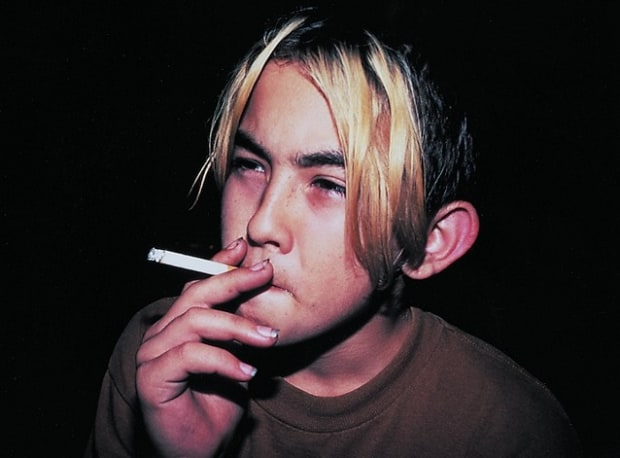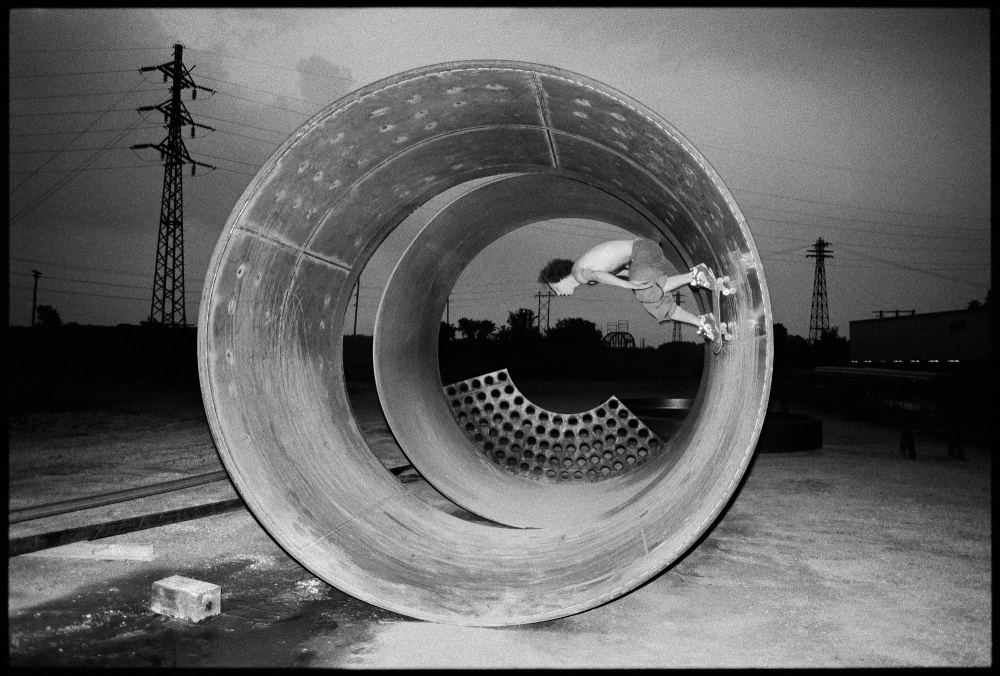

By Carolina A. Miranda
You may know Ed Templeton as a painter. (He is part of the stable of artists at Roberts Projects on La Brea.) You may know him as a photographer. (His images of punks, weirdos and burnouts in the environs of Huntington Beachappear regularly in exhibitions and surface regularly on his Instagram, @ed.templeton). You may also know him from his appearance, with Deanna Templeton, a fellow artist and his wife, in Beautiful Losers, a 2008 documentary directed by Aaron Rose and Joshua Leonard that chronicled the scene around the Alleged Gallery in downtown Manhattan in the 1990s. The film came after a related exhibition and catalog.
In addition to all of these various roles, Templeton, in the early 1990s and early 2000s, was a professional skateboarder. And throughout those years, he was never without a 50-millimeter camera.
Dozens—possibly hundreds—of his photographs from that era are now on view at the Long Beach Museum of Art, in the solo exhibition Wires Crossed: The Culture of Skateboarding, 1995-2012, which is on view through early May. The show follows the publication, last year, of a similarly titled book by photo stalwarts Aperture that likewise features many of these images. Kelefa Sanneh, in the New Yorker, described it as “unsparing but nonjudgmental.”
The same could be said for the exhibition, which captures a moment—largely prior to the saturation of social media platforms like Instagram (which launched in 2010)—in which subcultures could still largely remain subcultures without turning into viral fodder.
In clear-eyed ways, Templeton captured the messiness of his milieu: a destructive yet charming crew of skate punks with whom he inhabited a van and uninspiring motel rooms to stage professional demos and promote his skate line, Toy Machine (which is still going).
In his photographs, which are largely black-and-white, you’ll see skaters scoring weed, having sex, showing off their bruises and generally demonstrating little regard for authority. Skating enters the picture—including elegant scenes in which bodies sail choreographically along drainage pipes and hand rails. (I’ve always been intrigued by the ways that skaters, like graffiti artists, make such imaginative use of forgotten bits of infrastructure). But the show is less about skating than everything that surrounds it—toxic and not.
Photographs reveal androgynous innocence and weary worldliness. Templeton captures the reeling gaze of skaters in the wake of traumatic injuries. This includes an image of Templeton himself, in a photo by Patrick O’Dell, that shows him bloodied and in shock, a set of arms gently swaddling his injured head with a T-shirt. These images have all the drama of paintings of Catholic martyrdoms.
Particularly compelling are the sensitively made photographs of Elissa Steamer, who was often the lone woman on these tours. Templeton captures her toughness but also moments of intense vulnerability.
The artist adds a layer of intimacy to these photographs by drawing and painting on their surface, often adding text entries that transform the pictures into a diary. Moreover, the thoughtful installation clusters photographs in digestible arrangements, with hand-drawn maps by Templeton articulating the various journeys he and his band of outsiders survived.
Wires Crossed is about punks being punks. It’s also about camaraderie and friendship and love amid truly chaotic circumstances—not to mention a singular lens into a sport and a culture that was birthed and nurtured in Southern California.
Ed Templeton, Wires Crossed: The Culture of Skateboarding, 1995-2012, is on view at the Long Beach Museum of Art through May 5.
Photo: Ed Templeton, Mike Maldonado skating a pipe in Iowa in 1998.